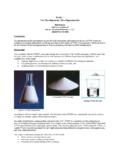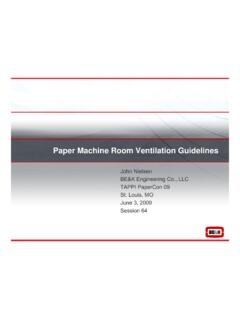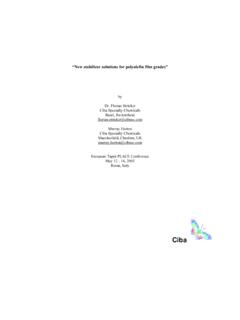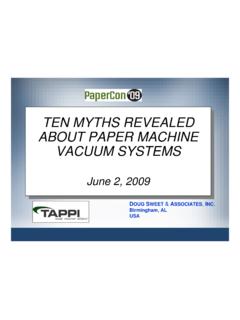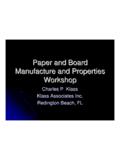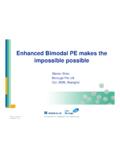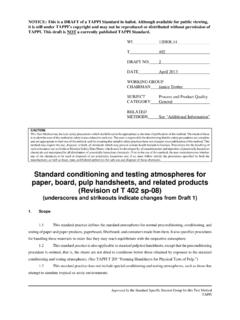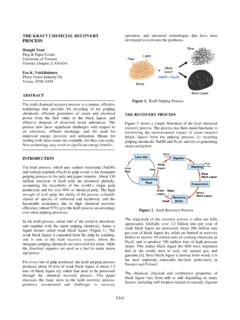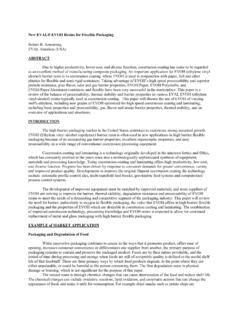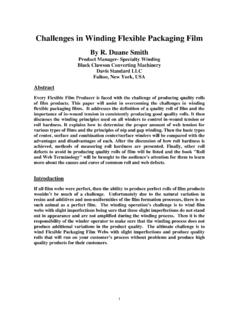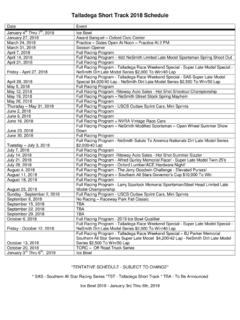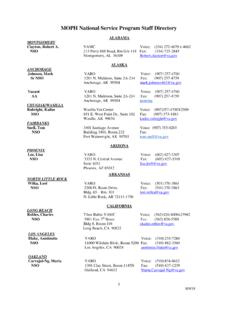Transcription of Air resistance of paper (Gurley method) (Revision of …
1 WI T 460 DRAFT NO. 2 DATE June 14, 2006 TAPPI WORKING GROUP CHAIRMAN JW Walkinshaw SUBJECT CATEGORY Physical Properties RELATED METHODS See Additional Information Approved by the Standard Specific Interest Group for this Test Method TAPPI CAUTION: This Test Method may include safety precautions which are believed to be appropriate at the time of publication of the method. The intent of these is to alert the user of the method to safety issues related to such use.
2 The user is responsible for determining that the safety precautions are complete and are appropriate to their use of the method, and for ensuring that suitable safety practices have not changed since publication of the method. This method may require the use, disposal, or both, of chemicals which may present serious health hazards to humans. Procedures for the handling of such substances are set forth on Material Safety Data Sheets which must be developed by all manufacturers and importers of potentially hazardous chemicals and maintained by all distributors of potentially hazardous chemicals. Prior to the use of this method, the user must determine whether any of the chemicals to be used or disposed of are potentially hazardous and, if so, must follow strictly the procedures specified by both the manufacturer, as well as local, state, and federal authorities for safe use and disposal of these chemicals. Air resistance of paper ( gurley method) (Revision of T 460 om-02) (Underlines in text indicate changes/revisions since last draft) 1.
3 Scope This method is used to measure the air resistance of approximately sq. cm. (l sq. in.) circular area of paper using a pressure differential of kPa. The recommended range of the liquid column instrument is from 5 to 1800 seconds per 100 mL cylinder displacement. For more impermeable papers the time requirements become so excessive that other techniques are preferable. This method measures the volume of air that passes through the test specimen, along with any possible leakage of air across the surface; therefore it is unsuitable for rough-surface papers which cannot be securely clamped so as to avoid significant surface and edge leakage. T 460 om-02 Air resistance of paper ( gurley method) / 2 For a similar method of measuring air resistance that tests paper at a higher pressure (approx. 3 kPa), and has higher resolution in measuring smaller air volumes, refer to TAPPI T 536. For a method of measuring air permeance at pressures up to kPa, using both smaller and larger test areas, refer to TAPPI T 547.
4 2. Summary This method measures the amount of time required for a certain volume of air to pass through a test specimen. The air pressure is generated by a gravity-loaded cylinder that captures an air volume within a chamber using a liquid seal. This pressurized volume of air is directed to the clamping gasket ring, which holds the test specimen. Air that passes through the paper specimen escapes to atmosphere through holes in the downstream clamping plate. 3. Significance The air resistance of paper may be used as an indirect indicator of Z-directional fluid permeance, as well as other variables such as: degree of refining, absorbency (penetration of oil, water, etc.), apparent specific gravity, and filtering efficiency for liquids or gases. Air resistance is influenced by the internal structure and also the surface finish of the paper . Internal structure is controlled largely by the type and length of fibers, degree of hydration, orientation, and compaction of the fibers; as well as the type and amount of fillers and sizing.
5 The measurement of air resistance is a useful control test for machine production; but due to the number and complexity of factors outlined above; careful judgment should be used in the specification limits for air resistance . 4. Definition Air resistance is the resistance to the passage of air, offered by the paper structure, when a pressure difference exists across the boundaries of the specimen. It is quantified by obtaining the time for a given volume of air to flow through a specimen of given dimensions under a specified pressure, pressure difference, temperature, and relative humidity. 5. Apparatus1 Oil sealed instruments Air resistance apparatus, consisting of a vertically positioned outer cylinder which is partly filled with a sealing fluid, and an inner cylinder that can slide freely in the outer cylinder. Air pressure, generated by the weight of the inner cylinder, is applied to the specimen which is held between clamping plates. 1 Names of suppliers of testing equipment and materials for this method may be found on the Test Equipment Suppliers list in the set of TAPPI Test Methods, or may be available from the TAPPI Quality and Standards Department.
6 3 / Air resistance of paper ( gurley method) T 460 om-02 The clamping plates are located at the bottom of the apparatus, and a center feed tube directs the pressurized air to the clamping plates. The top of the floating inner cylinder is closed. NOTE l: On some earlier instruments, the clamping plates are mounted on top of the floating inner cylinder. Refer to Appendix for additional details. Some versions of this apparatus utilize a hand-tightened capstan (jackscrew) arrangement to tighten the clamping plates together, while other versions are equipped with a dead weight (typically kg) loading a lever arm. The recommended clamping force is 180 30 newtons. This mechanism provides a technique to give uniform loading, and thus minimize the operator influence on the test. Controlled clamping force is the preferred method of clamping the specimen. An elastomeric gasket is attached to the clamping plate on the side exposed to air pressure to minimize the leakage of air between the surface of the paper specimen and the clamping plate.
7 The gasket is mm inside diameter and mm outside diameter. A satisfactory material is Thiokol, grade ST, polished plate molded, mm thick, 50-60 IRHD (International Rubber Hardness Degrees ISO 48). Other materials may be recommended by the instrument manufacturer. Since the hardness of the elastomer will change with age, this gasket must be replaced on a periodic basis to ensure optimum sealing characteristics. For alignment and protection, the gasket is cemented in a groove machined in the clamping plate. The groove is concentric with the aperture in the opposing plate. The groove is + mm inside diameter and about + mm outside diameter to fit the outside diameter of the basket, at a depth of mm. The outer cylinder is 254 mm high with an internal diameter of mm. It has four vertical bars, each mm long, mm wide and mm thick, mounted equidistantly on the inner surface of the outer cylinder to serve as guides for the inner cylinder. It has a fluid level indicator to assist in adding the proper amount of sealing fluid.
8 The inner cylinder is 254 mm high with an outside diameter of mm, an inside diameter of mm, and has a total mass of 567 g, so as to produce a nominal pressure of kPa. It is made of an aluminum alloy and has graduation marks on the outside diameter which represent the volume circumscribed within the cylinder. These marks are used to indicate a certain volume of air that passes through the clamping area that holds the paper specimen. The cylinder is graduated in units of 50 mL with a total range of 350 mL. NOTE 2: Some inner cylinders are also graduated in units of 25 mL for the first 100 mL, and have a graduation at the 400 mL interval. A stopwatch or electric timer, capable of recording time to the nearest second, is required. Some instruments are available with automatic timing devices. T 460 om-02 Air resistance of paper ( gurley method) / 4 Electronic instruments There is another technique in use (1) that utilizes an electronic mass airflow meter to measure the outflow of air from a paper specimen that is subjected to a pressure differential of kPa.
9 By measuring the outflow (discharge of air) from the specimen, surface leakage does not bias the measurement. The test results are virtually identical to those obtained from the liquid column instrument when there is no surface leakage at the clamping rings of the liquid column instrument. 6. Materials Sealing fluid: The outer cylinder is filled to the liquid level indicating mark with a lubricating oil having a kinematic viscosity of 10 to 13 mm /s (60-70 s Saybolt Universal) at 38 C and a flash point of at least 135 C. The specific gravity at 23 C must be between and NOTE 3: A light spindle oil is suitable for this purpose. Oil must be used instead of water because it does not affect the moisture content of the specimen. Also, the higher specific gravity of water will affect the volume of air that passes through the specimen, as there is a manometer effect that causes a different amount of air to pass through the specimen than indicated by the graduations on the inner cylinder.
10 7. Calibration The instrument can be tested for air leakage by clamping a thin piece of smooth impervious metal foil or cellophane between the clamping plates. A maximum leakage of 50 mL in 5 h is allowable. This test does not ensure a similar low surface leakage for a paper specimen under test. Electronic timing devices should be checked in accordance with the manufacturer's instructions. Calibration flow restrictor plates will facilitate this test. Perform the calibration checks in accordance with the manufacturer's instructions. 8. Sampling Obtain a sample of the paper in accordance with TAPPI T 400 Sampling and Accepting a Single Lot of paper , Paperboard, Containerboard, or Related Product. 9. Test specimens Prepare 10 test specimens of sufficient size from each test unit of the sample. A 50 mm square, or larger size, is generally adequate. 5 / Air resistance of paper ( gurley method) T 460 om-02 NOTE 4: The test results for some grades of paperboard may be affected by specimen cut size when there is inadequate stick-out from the clamping rings.
